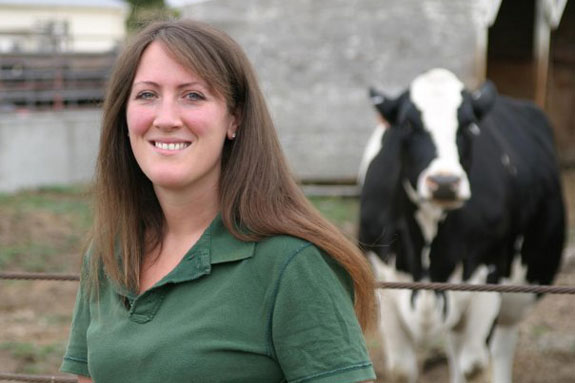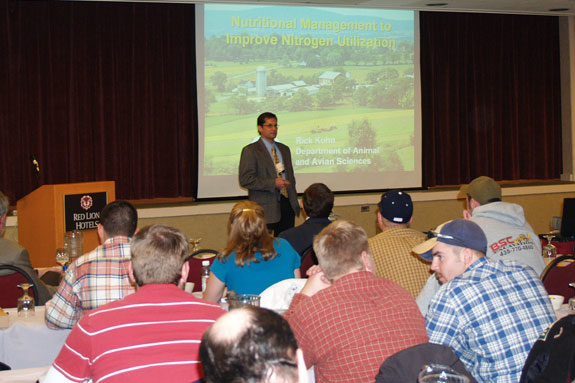Reproduction, fatty acids, carbon footprints to be featured at Four-State Pre-Conference Symposium June 9 in Iowa
The latest findings in dairy research will be presented at the 2010 Four-State Dairy Nutrition and Management Conference on June 9-10 at the Grand River Center in Dubuque, Iowa.
This conference, a collaboration of extension professionals from Iowa State University, University of Illinois, University of Minnesota, and University of Wisconsin, was developed to provide timely research information for dairy industry professionals.The following are pre-event comments from speakers scheduled to present at the pre-conference symposium on Wednesday morning.
Bill Thatcher 
Emeritus graduate research professor, Department of Animal Sciences
University of Florida
Session topic: Getting Cows Pregnant and Keeping Them Pregnant and Practical Omega Nutrition
Q. Why is this topic important?
THATCHER: Pregnancy rate over a 21-day period for the average herd of dairy cows in the U.S. is approximately 16 percent. Reproductive management systems have been optimized for timed inseminations with first service pregnancy rates approaching 45 percent in large commercial dairy herds. Their success is dependent on a sound understanding of why the programs work from a physiological perspective and the need to obtain high compliance when implementing the programs. Optimal reproductive management has identified the importance of restoring cows to a sound reproductive status after calving to achieve pregnancies in a timely manner. Coordinated herd health and nutritional management of the transition/postpartum cow improves reproductive performance.
Q. What do you hope attendees will take away from this presentation?
THATCHER: A thorough understanding of how timed insemination programs can improve first service pregnancy per timed insemination, and why what is practical for the producer is not necessarily optimal for the cow’s fertility.
Feeding supplemental fats is not just supplying energy to the cow, but that specific fatty acids can target pro-inflammatory and anti-inflammatory responses that benefit reproductive processes of the cow and be complementary to milk production.

Mike Overton
Associate professor, Dairy Production Medicine
University of Georgia
Session topic: Pregnancy Value in Your Herd
Q. Why is this topic important?
OVERTON: Traditionally mastitis, lameness and poor reproductive performance have been the top three most costly disease or management challenges facing most dairy herds. Despite the efforts to date, the average whole herd annual pregnancy rate in North America is likely only about 15 or 16 percent and this mediocre level of reproductive performance results in a large economic cost for these herds. As a consequence, many dairy herds have much to gain by improving reproductive performance.
Q. What do you hope attendees will take away from this presentation?
OVERTON: For many herds, there is a large potential economic benefit for improving the reproductive performance. The largest source of economic value from improving pregnancy rates is an increase in milk per cow per day as a consequence of decreasing the average days in milk. Other economic benefits include the production of more potential replacements, reduced reproductive-based culling and a greater opportunity for more aggressive selective culling. Efforts at improving reproductive success should first focus on increasing the insemination risk through improved estrus detection, improved performance within a timed A.I. protocol, or some combination of the two approaches. When examining the value of changes in pregnancy rate, herds with very poor reductive efficiency have the most to gain per unit change in pregnancy rate. Also, the value of milk and the level of milk production are two very large factors that determine the value of improving reproductive performance. Other important factors include the cost of replacements, the value of market cows, the cost of feed and the value of the bull and heifer calves.
Tom Jenkins 
Professor, Department of Animal & Veterinary Sciences
Clemson University
Session topic: Where Do All These Fatty Acids Come From and What They Do to My Cow?
Q. Why is this topic important?
JENKINS: Lipids in the feed of dairy cows have largely been ignored except for their contribution to energy intake, yet select polyunsaturated fatty acids in the diet can have major impact on animal performance and on the nutritional value of dairy products for human consumption.
Q. What do you hope attendees will take away from this presentation?
JENKINS: The source of fatty acids in the feed can be surprising, with major contributors coming from non-fat supplements.
Fatty acids in the feed are greatly transformed by the microbial population in the rumen, such that postruminal outflow of fatty acids guides animal performance more than fatty acid intake.
Fatty acid transformations in the rumen have both positive and negative effects on animal performance. The topic of greatest interest at present is the association of CLA produced in the rumen and milk fat depression.

Jude Capper
Assistant professor of dairy science, Department of Animal Sciences
Washington State University
Session topic: The Compatibility Between Dairy Efficiency and Carbon Footprint
Q: Why is this topic important?
CAPPER: Dairy producers are generally well aware of the positive effect that improving efficiency has upon economic parameters. Improving efficiency also reduces the carbon footprint of dairy production – if we improve productivity (milk produced per unit of resource input) that allows us to maintain milk production using fewer animals, less feed, less land, less fertilizers and less greenhouse gases. Improvements in productivity have allowed us to reduce the carbon footprint of milk by 63 percent since 1944 – we need to continue these efficiency gains to maintain sustainability as we move into the future.
Q: What do you hope attendees will take away from this presentation?
CAPPER: I hope attendees will gain a better understanding of the factors that affect the environmental impact of dairy production, the role that productivity must play in sustainable dairy production and the impact that producers, nutritionists and veterinarians can have upon the dairy industry’s carbon footprint.
To register for the conference online or obtain a downloadable brochure, go to www.wasa.org or contact Wisconsin Agri-Service Association at (608) 223-1111 .
PHOTO : Dr. Rick Kohn of the University of Maryland leads a discussion at a similar event, the Intermountain Nutrition Conference. Photo by PD staff.




